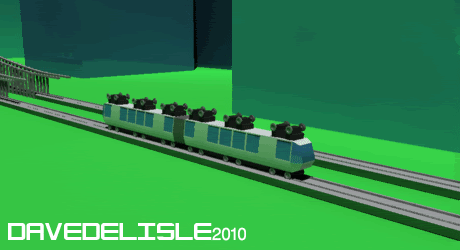The Quadrail Elevated Rail System
This is a system designed for high-density urban centers that are dealing with commuter trains that are exceeding passenger capacity. These particular systems might find it difficult to build more track, add more train frequency, or extend existing platforms.
Quadrail
The Quadrail system uses both standard trains and specially designated trains that are fitted with additional wheels on top. These wheels are designed to grasp elevated rails that will lift the train off the lower track and onto a short stretch of elevated track. This would make additional platforms a possibility, and also allow for actual express trains which would bypass stopped trains on the lower track.

(Wouldn't actually move this blazingly fast)
This system would would use existing rail lines, saving cost from having to expand. With some excellent planning, you could also create 2 directions of travel sharing a single line of track. With tiered platforms there would be less crowding. Trains could operate with more frequency. Idle trains would have a place to sit that isn’t obstructive.
And like strata buildings in dense urban areas, allowing stations to grow vertically instead of increasing their land footprint may be a desirable option.
This isn’t foolproof. Extensive safety measures would have to be employed to ensure one train doesn’t pancake another. The ‘jumping’ trains would need to be structurally sound to support the added wheels.
If you have been following this blog, you’ll notice I am influenced by real-world things much of the time, so it isn’t impossible:
Posted on June 3, 2010, in Transportation and tagged Environment, Transportation. Bookmark the permalink. 8 Comments.

Hi. I think that your idea has merit. I would use the new technology for all stops, and then use the old technology for the express trains. The idea is that the bump would naturally slow a train down, which could act as a breaking system.
A lot of the SkyTrain stations were designed that way.
-
Sincerely, and with thanks,
Eugene T.S. Wong
@Eugene: I think your way is equally true of what could be done. This system would offer much flexibility in regards to which line was express and which line is for frequent stops.
I just thought of something. There are some stations which are lower than an adjacent station. This means that either platform level could be used by the express train, as far as kinetic and potential energy go.
Have you thought of sharing your idea with technical people who actually deal with this stuff?
I wouldn’t be surprised if there is a way for us to create some kind of system, that allows regular train cars to be used, without modifying the car itself.
Yeah I mentioned there could be multiple platforms put to use if needed at these stations.
I’m not an engineer or anything, but some scientists have lent their 2 cents on my blog. I don’t actively seek out feedback, but it’s here for the taking. I continue to get many hits for BP Oil Spill ideas, for example - so there are people who seek these out too.
My ideas are for anyone to consume and use if they wish, and if something comes of it then awesome…just want to make some positive contributions if I can.
Interesting how a good idea comes back around. Ever hear of Boynton’s Bicycle Railroad? He actually built a demonstration section in Coney Island, Brooklyn, in the 1860s. (Everyone said it was crazy. Would never work. Idea shelved). And now here in the 21st century…
This is a crazy idea too! Only viable for congested train systems that have zero real estate for additional tracks. Then this ‘strata’ approach should be considered as a last resort methinks.
Pingback: The Crawling Mine-Eater « Dave's Ideas
Pingback: And Now For Something Completely Different….Er, Again. « Dave's Ideas